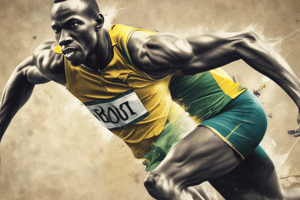Podcast
Questions and Answers
What is the main advantage of fiberglass handles used in bolt cutters?
What is the main advantage of fiberglass handles used in bolt cutters?
- Enhanced material hardness
- Increased cutting capacity
- Lighter weight (correct)
- Greater handle length
Bolt cutters can only cut through materials of low hardness.
Bolt cutters can only cut through materials of low hardness.
False (B)
List two types of bolt cutters mentioned.
List two types of bolt cutters mentioned.
End cut, Ratchet bolt cutters
Bolt cutters are usually available in sizes ranging from _____ to _____ inches.
Bolt cutters are usually available in sizes ranging from _____ to _____ inches.
Match the bolt cutter types with their descriptions:
Match the bolt cutter types with their descriptions:
What is the measurement standard used for bolt cutter sizes?
What is the measurement standard used for bolt cutter sizes?
Which type of blade is designed for easier insertion with an angled cutter head?
Which type of blade is designed for easier insertion with an angled cutter head?
Shear cut blades have blades that are inverted to each other, similar to normal paper scissors.
Shear cut blades have blades that are inverted to each other, similar to normal paper scissors.
What is the primary advantage of clipper cut blades?
What is the primary advantage of clipper cut blades?
The blade type that has equidistant blades from the two faces is called the ______ cut blade.
The blade type that has equidistant blades from the two faces is called the ______ cut blade.
Match the following bolt cutter blade types with their descriptions:
Match the following bolt cutter blade types with their descriptions:
Which type of bolt cutter is specifically designed to ensure hands stay free from surface while cutting?
Which type of bolt cutter is specifically designed to ensure hands stay free from surface while cutting?
What is the primary purpose of a bolt cutter?
What is the primary purpose of a bolt cutter?
The jaws of a bolt cutter are forged together with the handles.
The jaws of a bolt cutter are forged together with the handles.
What is the typical cutting force yielded by a bolt cutter for a 250 newton force on the handles?
What is the typical cutting force yielded by a bolt cutter for a 250 newton force on the handles?
A bolt cutter typically features a __________ for adjusting the blades.
A bolt cutter typically features a __________ for adjusting the blades.
Which component of a bolt cutter is responsible for the actual cutting?
Which component of a bolt cutter is responsible for the actual cutting?
Match the following bolt cutter components with their descriptions:
Match the following bolt cutter components with their descriptions:
Bolt cutters can come in different sizes and types to suit various cutting needs.
Bolt cutters can come in different sizes and types to suit various cutting needs.
Name one type of cutting configuration that bolt cutter blades may have.
Name one type of cutting configuration that bolt cutter blades may have.
Flashcards are hidden until you start studying
Study Notes
Bolt Cutter Overview
- Various designs and types of bolt cutters include:
- End cut, Ratchet bolt cutters, Electric Power Cutters, Hydraulic bolt cutters.
Bolt Cutter Size
- Measured by the length from the jaw tip to the end of the handle.
- Common sizes include:
- Inches: 12, 14, 18, 24, 30, 36, 42
- Centimeters: 30.5, 35.6, 46, 61, 76, 91.4, 107
Electrician Bolt Cutter
- Features fiberglass handles for cutting live electrical wires.
- Advantages:
- Lightweight compared to traditional handles.
- Useful during rescue operations.
Blade Types
- Different cutting blade types:
- Angle cut blade: Angled for easier insertion (25 to 35 degrees).
- Centre cut blade: Equidistant blades providing a balanced cut.
- Shear cut blade: Blades inverted like scissors for effective cutting.
- Clipper cut blade: Designed to cut flush against surfaces, keeping hands free of obstruction.
Bolt Cropper
- Tool for cutting bolts, chains, padlocks, rebar, and wire mesh.
- Characteristics:
- Long handles and short blades to maximize leverage.
- Provides approximately 20 kilonewtons (4,500 lbf) cutting force with a 250 newton (56 lbf) force applied to handles.
Bolt Cutter Components
- Key components include:
- Blades: The cutting surfaces of the jaws, available in various configurations.
- Jaws: Form the head, secured to the handles by neck connections and bolts.
- Jaw Joint: Connects the jaws to the handle for operation.
- Handles: Integral for grasping and applying force, equipped with grips for user comfort.
Additional Information
- Bolts and joints enhance the functionality and strength of the cutter, allowing for effective performance across tasks.
Studying That Suits You
Use AI to generate personalized quizzes and flashcards to suit your learning preferences.




